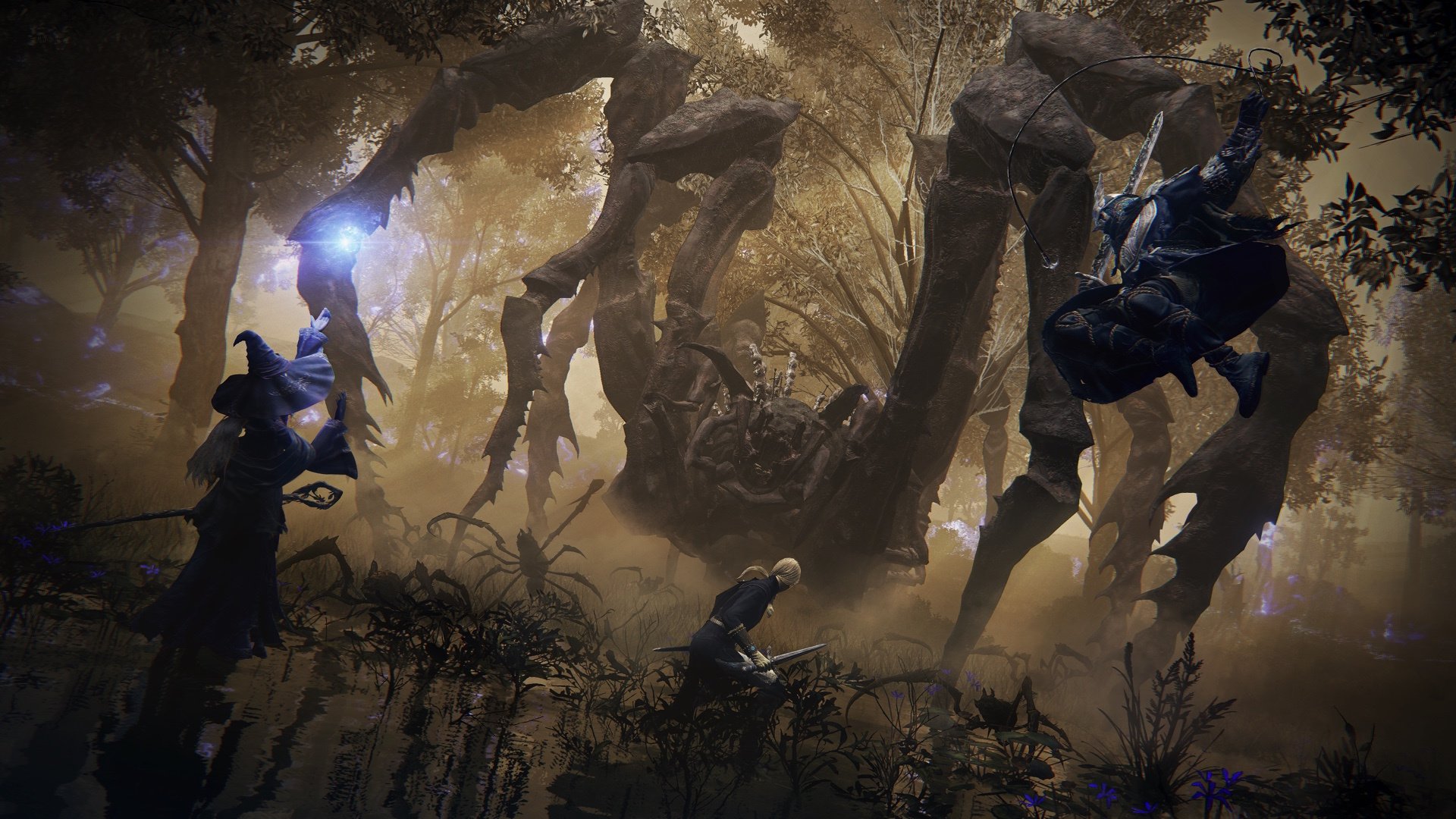Why you can trust TechRadar
We spend hours testing every product or service we review, so you can be sure you’re buying the best. Find out more about how we test.
With Elden Ring Nightreign, FromSoftware has created the definitive blueprint of how to use the parts of an existing game to craft an entirely different experience. In doing so, the developer has built a refreshingly freeing and flexible co-op experience that draws upon Elden Ring’s best bits while continuing to innovate and push FromSoftware into new territory, even if the matchmaking and co-op still feel partially stuck in the past.
Review information
Platform reviewed: PS5
Available on: PS5, Xbox Series X|S, PC
Release date: May 30, 2025
FromSoftware has always reused aspects of its previous games for new IPs or titles. For example, Bloodborne and Dark Souls animations can be found in Elden Ring, and Sekiro: Shadows Die Twice bosses like the Blazing Bull were given a new paint job in Elden Ring to create the Fallingstar Beast. It’s a smart, efficient way to constantly generate new content and worlds without having to redo a bunch of work.
But here, the studio goes one step further and uses Elden Ring’s bones to craft a game in an entirely new genre, resulting in a clever roguelike with a lot more going on than first meets the eye. On top of that, unsurprisingly, Elden Ring Nightreign is an incredibly fun and addictive combat experience on par with FromSoftware’s other work.
A convergence of worlds
Set in an alternate timeline from the main lore of Elden Ring, in Nightreign, you play as one of eight Nightfarers. These are mysterious characters with their own combat specialisms that act as classes. They have been summoned to the land of Limveld and the Roundtable Hold. Upon meeting a mysterious hooded maiden, you are urged to survive three days in Limveld and defeat the Nightlord who appears on the third day. Fail and you begin your journey in Limveld again from the beginning of your first day.
During each day, you will drop into a random spot in Limveld and explore the map, gearing up as a ring of rain called The Night’s Tide closes in on you from all directions. Upon exploring during a 45-minute run, you will come across an assortment of castles, outposts, camps, and landmarks from Elden Ring that are filled with randomized enemies, loot, items, consumables, and, most importantly, bosses from the base game and even some of the older Dark Souls titles.
You can also find nods to other FromSoftware games, whether it be a character’s ability that resembles a Bloodborne weapon or reference to a beloved Souls NPC.
Despite seeing bosses and references from old games pop up, they never felt like eye-rolling fan-service moments. It was actually fascinating to see how these challenges from older games have been updated to keep up with Elden Ring’s combat, and there are compelling lore tidbits hidden away in the game that hint at what has caused these many worlds to collide and why these Nightfarers have been brought together.
Learning the lay of the land
While it takes a few runs through Limveld to attune to the game’s faster pace and freeform structure, by the time I tackled my first Nightlord, I was already addicted to the captivating concoction FromSoftware had cooked up.
Instead of a guiding path pulling you and your friends from location to location, Nightreign is all about learning how to make the most of each day in Limveld. Whether that is running from boss to boss at each landmark to stock up on Runes and upgrades to obtain new weapons or level up, exploring caves to find smithing stones to enhance your armaments, or traversing the map to find extra healing flasks to improve your survivability.
Best bit
Finally defeating the Darkdrift Knight after several attempts, only succeeding because my rapier dealt rot damage and slowly ticked down his health as we all dodged attacks with low health and no healing flasks left. The Darkdrift Knight is the hardest fight in the game, I think, and the satisfaction, rush, and relief at finally beating it was immense.
It is very easy to think Nightreign is a brainless boss rush, combat sandbox at first glance, but it is actually a considered roguelite that focuses on map knowledge, where to find the best loot, and when it is best to adjust strategies in a similar way to a battle royale or extraction game. The satisfaction of doing this also reminds me a lot of the best puzzle games like Return of the Obra Dinn or Blue Prince, where you finally decipher how a mechanic works or uncover a clue.
Learning the map and how to optimize my runs through Limveld was one of the most satisfying parts of Nightreign. It is not something I expected to be as vital as it is, but through talking with others in voice chat, sharing findings from our own individual runs, and combining ideas, we eventually found buried strategies.
Examples include figuring out how to max out our level or discovering how to obtain the most legendary weapons in a run to increase our chances of defeating the Nightlords. This sense of player discovery and word-of-mouth knowledge that was rife throughout Elden Ring’s launch is just as potent here in Nightreign, and it’s part of the magic that makes it work, especially if you are able to play with a large group of friends or Discord server.
The same goes for the game’s overarching progression, which revolves around randomized relics you unlock at the end of runs through Limveld. Three of these can be equipped before each run on each character in the Roundtable Hold and unlock small buffs like extra elemental damage, or bigger Nightfarer bonuses like enhancing Nightfarer abilities or allowing you to share the healing from your healing flasks with your co-op partners – giving you triple the healing if standing near each other.
I heard about abilities on these that I never saw from other people while playing during the review period, and the flexibility of Elden Ring’s many levelling systems, elemental damage types, weapons, and the Nightfarers themselves open up the possibility for hundreds, if not thousands, of build combinations and optimizations.
Play your way
Nightreign is about doing as much as you can with the little time you have, rewarding players who stick together and melt bosses in seconds. It encourages teams to combine abilities and attacks to stun foes quickly, while communicating to ensure they are all on the same page.
This makes it an incredibly hard game to play alone (which is an option that is available). While it can be done, the game’s enemy scaling and progression rewards teams that can complete as many objectives as possible, which just isn’t easy to do on your own.
I could spend ages talking at length about the Nightlords themselves, but in reality, fans already know what to expect, and the actual structure and systems in Nightreign are far more innovative. Even still, these Nightfarer fights are incredible spectacles, and some of the best FromSoftware has made. They are brimming with difficult moves to master and a combination of abilities and forms to learn, all set against an impressive, bombastic orchestral soundtrack for each one. FromSoftware simply doesn’t miss when it comes to combat and enemy design, and Nightreign is no different.
One area FromSoftware could have fumbled is the Nightfarers. While they could have felt like cheap forced classes, they are actually really flexible and well-rounded archetypes, with abilities that have a variety of uses. For starters, every Nightfarer can use any weapon or item. If you want to play the katana-wielding, parry-centric Executor with a dagger, you can, even though you won’t be as effective as you would be with a katana.
This means you can craft your build on the fly and you never feel locked into a certain playstyle, allowing you to adapt during your run through Limveld. Bows don’t have ammo, and weight isn’t factored in either, which gives the game’s combat a brisk speed and pace that isn’t found in Elden Ring. It also removes a lot of the barriers to enjoying the game’s wide variety of weapon types, as you can basically pick up anything and begin using it right away. Yes, they actually made ranged combat and magic fun here.
On top of that, the ability kits for each Nightfarer are multi-faceted with several uses that aren’t immediately obvious. For example, Ironeye, the archer, can use his Single Shot ultimate ability to fire a huge supersonic arrow. That arrow can be used to stun larger bosses, wipe out hordes of mobs, and also revive teammates instantly if they are downed. Not only can it do those things individually, but you can also do all three at once with a well-placed shot, and it has saved my team’s run many times.
Each character and their abilities can be used in many ways to deal damage and also support your party and discovering how to utilise them in new ways is just as satisfying as discovering Limveld itself. You can also easily use three of one Nightfarer or any combination and succeed, removing even more barriers, as you don’t need any particular Nightfarer to come out victorious (even if some of them have stronger abilities than others).
Some major barriers to Nightreign, however, do emerge after a few hours. Because so much of Nightreign comes from Elden Ring, it is imperative that you have that existing knowledge to enjoy what Nightreign is offering. You can’t sit and try to fight the Golden Hippopotamus again and again to learn its attacks, because the next time you run through Limveld, it could be in a different location or not spawn at all.
The same goes for the Nightlords. You can’t just skip to the third day and practice them over and over, you need to complete a full 45-minute run through Limveld to reach them again, which is taxing. So, you need to be familiar with Elden Ring’s combat and have completed both the base game and the Shadow of the Erdtree expansion because of the difficulty of some of those Nightlords.
While returning players will be able to pick things up after a few runs, it feels like Nightreign is built for the hardcore Soulslike players and addicts who have memorised every attack pattern in Elden Ring and across FromSoftware’s pantheon of titles.
Another key issue at the time of this review is the matchmaking and lack of crossplay. During the pre-release period, we had issues creating lobbies using passwords where matchmaking would fail or simply not put players together when we all tried to matchmake with the same password set. Nightreign definitely retains some of the dated multiplayer quirks of FromSoftware’s other games.
It is also unforgivable in my eye that in the year 2025 Nightreign doesn’t have crossplay, and because of the demanding nature of the game and the reliance on communication, I simply do not see how you can complete any of the Nightlord bosses reliably, especially the tougher ones, without friends whom you know and people you can talk to. I don’t necessarily think this is a straight-up weakness of the game, but it’s a huge condition attached to the game that will prevent a lot of people from seeing everything it has to offer.
Should I play Elden Ring Nightreign?
Play it if…
Don’t play it if…
Accessibility
Elden Ring Nightreign offers limited accessibility options. There are basic speed adjustments for the camera and aiming with ranged weapons. There are no difficulty settings, and the game is best played in a co-op party of three, where you can communicate, which may not be possible for everyone.
There is also no subtitle customization or HUD alteration options, and there are no specialist options for those with eyesight or hearing issues. While you can rebind some controls on console, you cannot rebind every button, potentially preventing some people from playing on custom controllers.
How I reviewed Elden Ring Nightreign
I played Elden Ring Nightreign for 30 hours, completing all of the game’s Nightlord bosses and experiencing most of the world and map events available. I played the game entirely in performance mode on PS5 with a DualSense Edge controller on a Gigabyte M28U gaming monitor and using SteelSeries Arena 3 computer speakers.
This review was conducted in an environment where I was able to team up with other creators and journalists reviewing the game to play with them and complete the game’s various challenges.
First reviewed May 2025
Read the full article here













